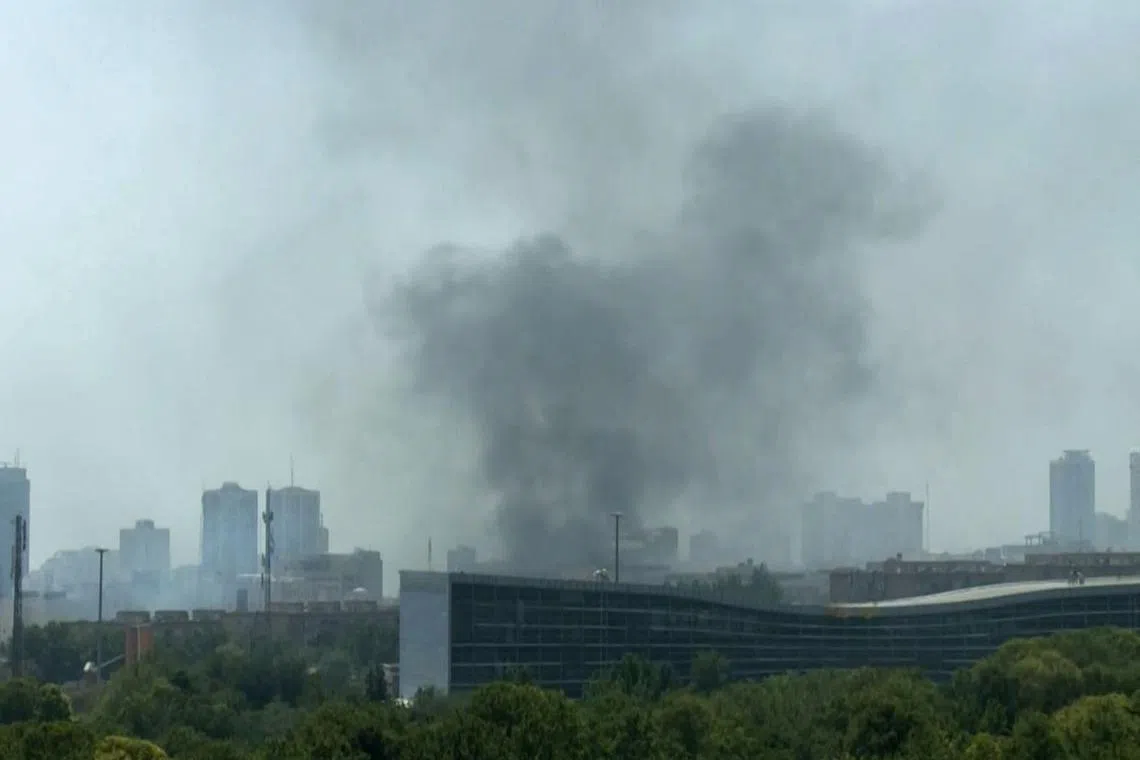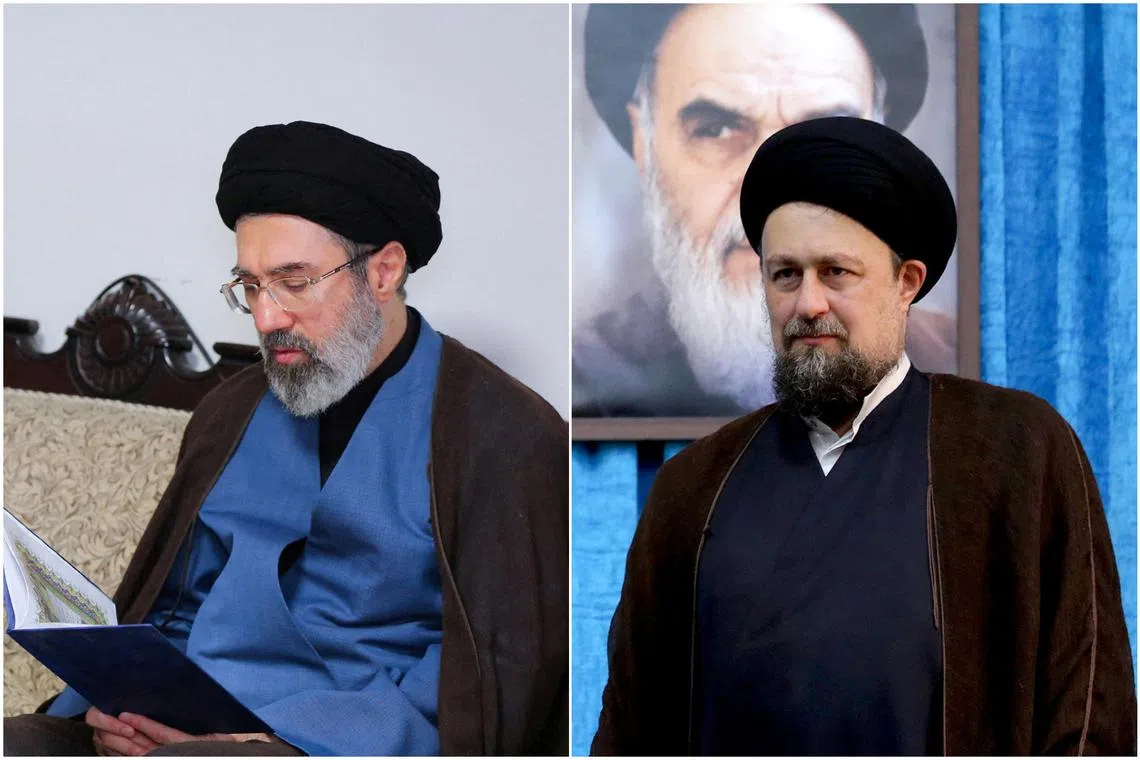Israel hits Iran’s Evin prison a day after US joins the war
Sign up now: Get ST's newsletters delivered to your inbox

Smoke billowing after Israeli strikes in Tehran on June 23. Israel struck Evin prison in northern Tehran on June 23, a potent symbol of Iran’s governing system.
PHOTO: AFP
Follow topic:
ISTANBUL - Israel struck Evin prison in northern Tehran on June 23, a potent symbol of Iran’s governing system, in what Israel called its most intense bombing yet of the Iranian capital a day after the United States joined the war.
Iran repeated earlier threats to retaliate
Oil prices barely budged on the first trading day after the US joined the war, suggesting traders doubted Iran would follow through on threats to disrupt oil supplies from the Gulf.
Iran’s Irib state broadcaster released video showing rescue workers combing the flattened wreckage of Evin prison, carrying a wounded man on a stretcher.
The Mizan news outlet of Iran’s judiciary said urgent action was being taken to protect the health and safety of inmates.
Israeli Foreign Minister Gideon Saar posted a video on X showing an explosion at a building with a sign identifying it as an entrance to the prison.
“Viva la libertad!” Mr Saar wrote. The phrase is Spanish for “long live freedom”.
Reuters could not immediately verify the video posted by Mr Saar, although other videos showing the aftermath were verified as genuine.
Evin has been the primary prison for housing political detainees and security prisoners, notably since Iran’s 1979 revolution, and the site of executions that remain potent symbols for the opposition.
It is where several high-profile foreign prisoners are also held.
The Israel Defence Forces said Israel had also struck Revolutionary Guard command centres responsible for internal security in the Tehran area.
“The IDF is currently striking, with unprecedented force, regime targets and governmental repression bodies in the heart of Tehran,” Defence Minister Israel Katz said in a statement.
There were conflicting reports on Iranian media about the full extent of strikes on Tehran, a city of 10 million people where much of the population has fled after 10 days of bombing.
Tasnim news agency reported a strike at an electricity feeder station in the Evin neighbourhood.
Power company Tavanir reported that some areas in the capital saw electricity cuts.
Iran’s student news network reported that Shahid Beheshti University, one of the main universities in Tehran, had also been hit.
The university’s public relations office denied it.
Limited options
Since Mr Trump joined Israel’s campaign by dropping massive bunker-buster bombs
But while it has continued to fire missiles at Israel, it has yet to take action against the US itself, either by firing at US bases or by targeting the 20 per cent of global oil shipments that pass near its coast at the mouth of the Gulf.
“Mr Trump, the gambler, you may start this war, but we will be the ones to end it,” Mr Ebrahim Zolfaqari, spokesman for Iran’s Khatam al-Anbiya central military headquarters, said on June 23 in English in a recorded video statement.
Mr Trump’s administration has repeatedly said that its aim is solely to destroy Iran’s nuclear programme, not to open a wider war
But in a social media post on June 22, Mr Trump spoke of toppling the hardline clerical rulers who have been Washington’s principal foes in the Middle East since Iran’s 1979 revolution.
“It’s not politically correct to use the term, ‘Regime Change,’ but if the current Iranian Regime is unable to MAKE IRAN GREAT AGAIN, why wouldn’t there be a Regime change??? MIGA!!!” he wrote.
Five insiders with knowledge of the discussions said efforts had been ramped up to anoint a successor
Mr Khamenei’s son Mojtaba, 56, and Mr Hassan Khomeini, 53, grandson of the founder of the revolution Ruhollah Khomeini, are now seen as the two front runners.
The younger Mr Khomeini, an ally of reformists who commands the respect of hardliners because of his lineage, came into the frame as a serious candidate in June because he could represent a more conciliatory choice internationally and domestically than Mr Mojtaba Khamenei, the five people said.

Mr Mojtaba Khamenei (left) and Mr Hassan Khomeini are seen as the two front runners in succeeding Iran’s 86-year-old supreme leader.
PHOTOS: REUTERS
More Israeli strikes
Israel’s air strikes on Iran have been met with little resistance from Iranian defences since Israel launched its surprise attack on June 13
Iranian officials said last week that more than 400 people had been killed in the Israeli attacks, mostly civilians.
Israel says Iran’s retaliatory missile strikes
The Israeli military said a missile launched from Iran early on June 23 had been intercepted by Israeli defences.
Air raid sirens blared overnight in Tel Aviv and other parts of central Israel.
But Iran’s ability to retaliate is far more limited than a few months ago, since Israel inflicted defeat on Iran’s most feared regional proxy force
Iran’s most powerful client ruler, Syria’s Bashar al-Assad, fell soon after
Iran’s most effective threat to hurt the West would be to restrict global oil flows from the Gulf, but oil prices have not shot up to crisis levels.
After briefly jumping above US$80 a barrel at the open
Prices are still above the level before Israel started its attacks in June. Traders said even that premium could fade.
“It’s worth noting that the current geopolitical risk premium – now exceeding US$10 per barrel – cannot be sustained for long without a tangible supply disruption,” said Mr Ole Hansen, head of commodity strategy for Saxo Bank.
Iranian lawmkers have discussed shutting the Strait of Hormuz
US Secretary of State Marco Rubio played down the threat.
“It’s economic suicide for them if they do it. And we retain options to deal with that,” he said. REUTERS

